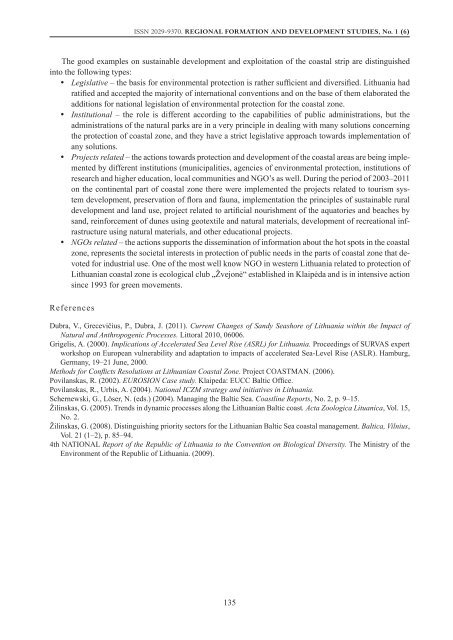Regional Formation 2012,1 - KlaipÄdos universitetas
Regional Formation 2012,1 - KlaipÄdos universitetas
Regional Formation 2012,1 - KlaipÄdos universitetas
Create successful ePaper yourself
Turn your PDF publications into a flip-book with our unique Google optimized e-Paper software.
ISSN 2029-9370. <strong>Regional</strong> <strong>Formation</strong> and Development Studies, No. 1 (6)<br />
The good examples on sustainable development and exploitation of the coastal strip are distinguished<br />
into the following types:<br />
• y Legislative – the basis for environmental protection is rather sufficient and diversified. Lithuania had<br />
ratified and accepted the majority of international conventions and on the base of them elaborated the<br />
additions for national legislation of environmental protection for the coastal zone.<br />
• y Institutional – the role is different according to the capabilities of public administrations, but the<br />
administrations of the natural parks are in a very principle in dealing with many solutions concerning<br />
the protection of coastal zone, and they have a strict legislative approach towards implementation of<br />
any solutions.<br />
• y Projects related – the actions towards protection and development of the coastal areas are being implemented<br />
by different institutions (municipalities, agencies of environmental protection, institutions of<br />
research and higher education, local communities and NGO’s as well. During the period of 2003–2011<br />
on the continental part of coastal zone there were implemented the projects related to tourism system<br />
development, preservation of flora and fauna, implementation the principles of sustainable rural<br />
development and land use, project related to artificial nourishment of the aquatories and beaches by<br />
sand, reinforcement of dunes using geotextile and natural materials, development of recreational infrastructure<br />
using natural materials, and other educational projects.<br />
• y NGOs related – the actions supports the dissemination of information about the hot spots in the coastal<br />
zone, represents the societal interests in protection of public needs in the parts of coastal zone that devoted<br />
for industrial use. One of the most well know NGO in western Lithuania related to protection of<br />
Lithuanian coastal zone is ecological club „Žvejonė“ established in Klaipėda and is in intensive action<br />
since 1993 for green movements.<br />
References<br />
Dubra, V., Grecevičius, P., Dubra, J. (2011). Current Changes of Sandy Seashore of Lithuania within the Impact of<br />
Natural and Anthropogenic Processes. Littoral 2010, 06006.<br />
Grigelis, A. (2000). Implications of Accelerated Sea Level Rise (ASRL) for Lithuania. Proceedings of SURVAS expert<br />
workshop on European vulnerability and adaptation to impacts of accelerated Sea-Level Rise (ASLR). Hamburg,<br />
Germany, 19–21 June, 2000.<br />
Methods for Conflicts Resolutions at Lithuanian Coastal Zone. Project COASTMAN. (2006).<br />
Povilanskas, R. (2002). EUROSION Case study. Klaipeda: EUCC Baltic Office.<br />
Povilanskas, R., Urbis, A. (2004). National ICZM strategy and initiatives in Lithuania.<br />
Schernewski, G., Löser, N. (eds.) (2004). Managing the Baltic Sea. Coastline Reports, No. 2, p. 9–15.<br />
Žilinskas, G. (2005). Trends in dynamic processes along the Lithuanian Baltic coast. Acta Zoologica Lituanica, Vol. 15,<br />
No. 2.<br />
Žilinskas, G. (2008). Distinguishing priority sectors for the Lithuanian Baltic Sea coastal management. Baltica, Vilnius,<br />
Vol. 21 (1–2), p. 85–94.<br />
4th NATIONAL Report of the Republic of Lithuania to the Convention on Biological Diversity. The Ministry of the<br />
Environment of the Republic of Lithuania. (2009).<br />
135
















